At 2.5 million light-years away, you might think it's impossible to see individual stars in the Andromeda Galaxy. Let its largest star cloud, NGC 206, show you the way.
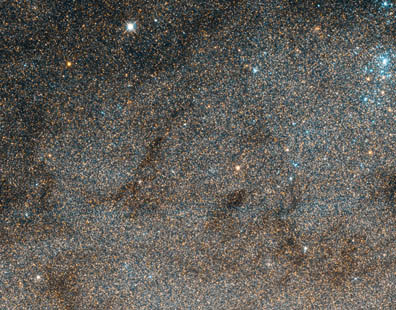
NASA / ESA / Hubble Heritage Team
I always figured I'd have to wait until the next supernova to see an individual star among the trillion that comprise the Andromeda Galaxy. At the galaxy's distance of 2.5 million light-years, the stars blend into a luminous stellar fog. Whenever I show Andromeda to the public, I make sure to remind each viewer that the haze they see is actually the light of billions of individual stars too far and faint to resolve into individual pinpoints.
In binoculars and small telescopes, it's easy to distinguish the core, where stars are more strongly concentrated, from the less populated arms. Those with 10-inch and larger telescopes can survey the galaxy's brighter globular star clusters and stellar associations with the aid of detailed maps. But individual stars?
Several years back, I briefly observed a bright nova just outside the galaxy's nucleus in my 15-inch reflector when it peaked around magnitude 14.9. That was a lucky break as most novae in M31 max out around magnitude 17-19 and require telescopes upwards of 20-inches to track down.
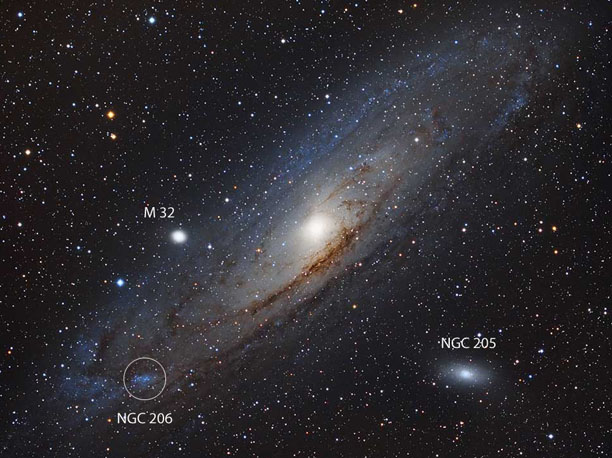
Patrick Winkler / Online Photo Gallery
Then one fall night, while hunting down globulars and other minute delights in the galaxy, I shifted the scope to NGC 206, M31's largest and brightest star cloud. The object, which resembles a weakly condensed 10th-magnitude comet superimposed on Andromeda's southwestern arm, measures 4.2′ across. Its true size is about 4,000 light-years across or nearly three times the distance from Earth to the star Deneb in the Northern Cross, making it one of the largest star clouds in the Local Group of galaxies.
If you haven't observed it yet, you've probably noticed this distinctive hazy patch in photos of Andromeda. NGC 206 also goes by the name OB 78 and resembles the vast Perseus OB 1 association which includes the bright and well-known Double Cluster.
OB associations, named after the brilliant class O and B stars they contain, are loosely organized gaggles of young stars and star clusters born in the collapse of a giant molecular cloud. True star clusters, more compact by nature, keep hold of their stars through gravitational attraction. Thinly spread OB associations make easy prey for galactic tides, which pull associations apart and disperse their members far and wide.
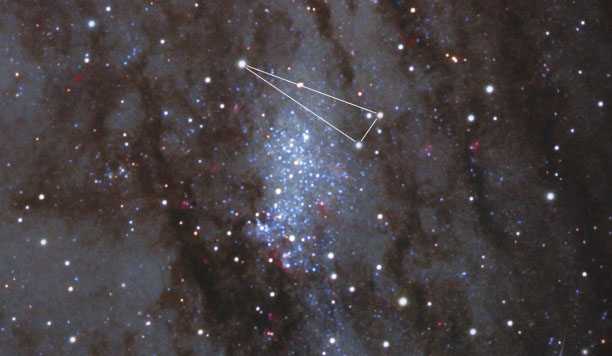
Michael A. Siniscalchi
NGC 206 is home to some 300 brilliant blue stars, the youngest of which are just 10 million years old, incredibly young by stellar standards. Stars 20 times more massive than the Sun are common with a few topping out at more than 40x solar! Inspired by these superlatives and photos that showed good resolution of the cloud, I cranked up the magnification to 242x and then 357x, allowed my eyes to fully adapt to the darkened field of view and got the surprise of my life. Stars!
NGC 206 appeared in three sections: a tiny ~30″ wide knot dotted by a 16th magnitude star, a brighter, clumpy northern "cloud" and a fainter, more distended southern section separated by a relatively haze-free gap (in other words, no unresolved stars). Direct vision revealed several faint stellar points around and within the cluster, some of which were members of the association and not Milky Way foreground suns.
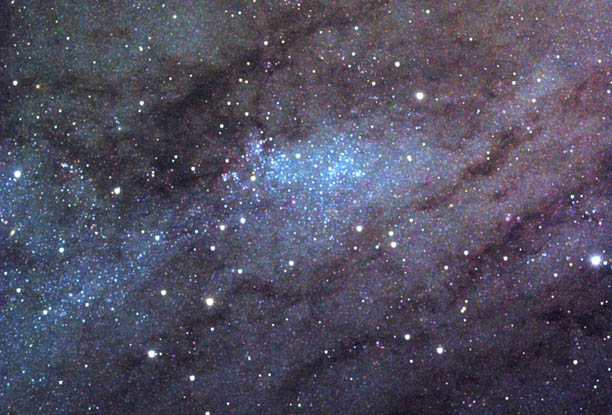
Jim Misti
But the thing that positively electrified the view was seeing OB 78 materialize into a rich spray of barely visible stars with averted vision. They came and went with the vagaries of my eye's position and seeing conditions, but there was no question I was seeing cluster stars based on location and star density compared to the ambient Milky Way foreground. The scene reminded me of the grainy interiors of the remote globular clusters NGC 7006 in Delphinus and the "Intergalactic Wanderer," NGC 2419, in Lynx.
In all three cases, it was next to impossible to hold so many faint stars in view long enough to see them individually or connect them into patterns. Instead, they appeared as a granulated haze or mist of dim points that flashed in and out of view.
Stephen Odewahn of the McDonald Observatory surveyed NGC 206 in the 1980s and published a photometric survey of its brightest stars. While most are hopelessly faint for visual observers even with moderately large telescopes, 5 members range between about magnitude 15.5 and 17.0, making them somewhat less hopelessly faint.
A 15-inch scope covers the brighter end of that range with ease, but the number of stars I glimpsed with averted vision implies that in some situations, based on seeing, magnification and experience, we can momentarily best a telescope's limiting magnitude by a surprising margin.
No one should be content with a single observation of faint nothings, so I re-observed the star cloud on several occasions and confirmed my observation using friends' 18-inch and 24-inch telescopes. We invited several members of our clubs to view NGC 206 and every one of them was able to at least partially resolve the stellar association in each scope.
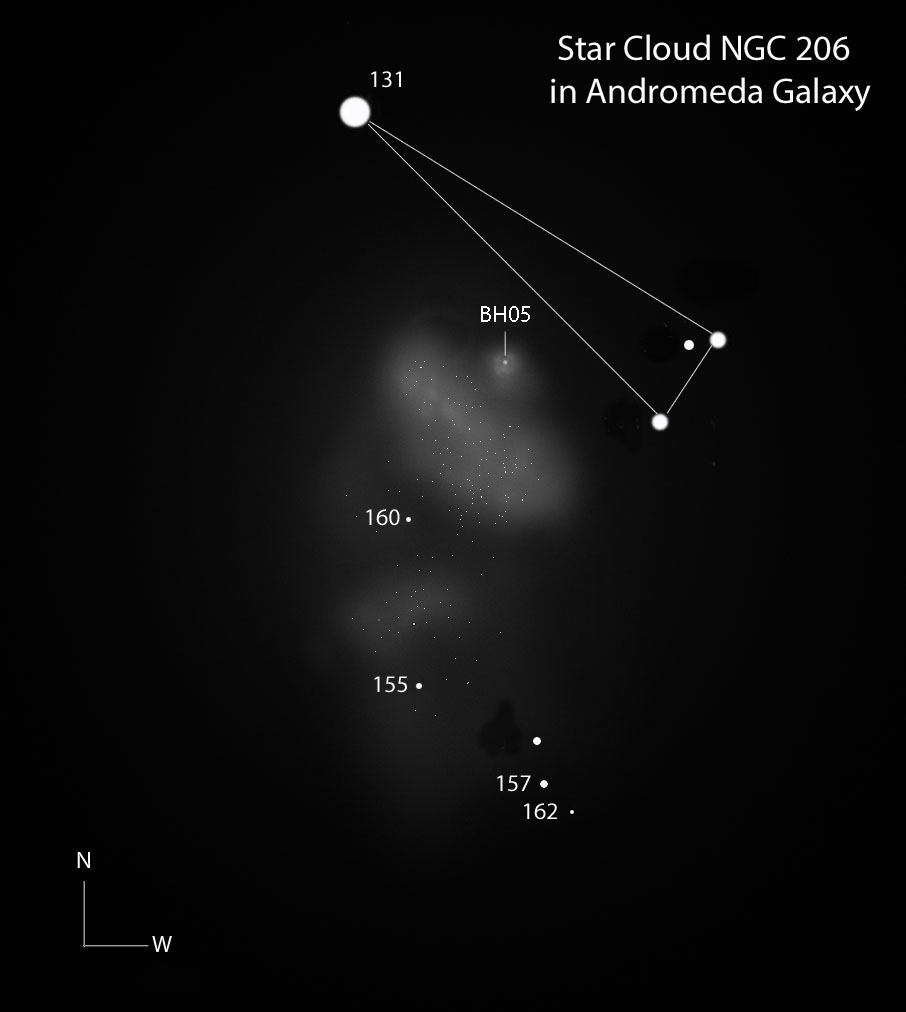
Bob King
Using a photo labeled with some of the brighter stars from Odewahn's paper, I was able to clearly see and identify four stars between magnitudes 15.5 and 16.2 in the 15-inch. I've included these in a drawing made using Photoshop that I hope will provide a useful tracking guide for your own explorations.
While a 24-inch scope reveals even more stars, a 15-inch scope is easily up to the task of breaking out some of Andromeda's brightest blue supergiant stars from this magnificent clutch of stellar celebrities. Daring amateurs may even want to put a 10 or 12-inch scope to the task. I'd love to know what you'll see.
** (Correction and update — July 3, 2021: I'm grateful to amateur astronomer Scott Harrington who kindly provided correct information about the nature of the star labeled 16.0 in my original sketch, which I've completely updated. Astronomer Paul Hodge and team used the Hubble Space Telescope to identify it as a massive young open cluster in M31 called BH05. You can read the details in their 2010 paper. There exists the possibility that based on the warmer colors of the four stars described that one or more may not be true cluster members. I will further update in the weeks ahead.)
 19
19








Comments
October 5, 2016 at 11:44 am
I'd love to have a telescope big enough to resolve stars in Andromeda. That's just not in the budget. I have to be content just to see a galaxy in my little refractor. I have seen several in the Virgo cluster, as well as Andromeda and M81 and M82. Quite a few globulars as well.
You must be logged in to post a comment.
Bob KingPost Author
October 5, 2016 at 11:49 am
Hi AlphaC,
Understandable. Next time you have a chance to view the Andromeda Galaxy under dark skies, you might at least be able to see its giant star cloud, a thrill in itself.
You must be logged in to post a comment.
sandmanchang
October 6, 2016 at 10:33 am
Hi Bob, great article. I was inspired after reading it last night to view NGC206 with my C14 and Mallincam. This combo easily resolved NGC206 into a swarm of tiny stars, many of which are distinctively blue. It was very exciting to see distinct stars in M31!
thanks for a very informative articoe
Sandy
You must be logged in to post a comment.
Bob KingPost Author
October 6, 2016 at 1:25 pm
Hi Sandy,
So glad you enjoyed the article and thank you for sharing your observation. Whether visually or photographically this is a glittery group!
You must be logged in to post a comment.
Peter Rowen
October 18, 2016 at 3:30 pm
Just a suggestion: Many large professional 'scopes have observing nights scheduled when they allow the public to view. Some even allow target suggestions, but I imagine the Andromeda galaxy would be on everyone's target list in any case. Two I know of are Goldendale Observatory in Washington, and Kitt Peak in Arizona. Get Googling for a site in your area! Weather permitting, it's always a memorable experience.
You must be logged in to post a comment.
Donald E Pensack
October 7, 2016 at 4:49 pm
Bob,
About a half dozen of the stars superimposed on NGC206 are in the Milky Way and are just "line of sight" stars.
However, I've seen over a dozen of the stars in this area with a 12.5" at a dark site in superb seeing (the key to see faint stars in this cluster), meaning about a half dozen stars in M31.
It's really cool to know you've seen supergiant stars in another galaxy. 12.5" is not all that large of a scope.
Don Pensack
Los Angeles
You must be logged in to post a comment.
Bob KingPost Author
October 7, 2016 at 11:42 pm
Donald,
Yes, there are indeed some foreground stars but as you discovered, the cluster (cloud) is unmistakable under dark skies. Nice to hear you were able to resolve parts of it in a 12.5-inch. I hope your observation inspires others to do the same.
You must be logged in to post a comment.
bwana
October 7, 2016 at 7:08 pm
I tell my kids and grandkids this region of Andromeda shows the amount of light pollution the galaxy's inhabitants are generating. My kids think I'm a little crazy. My grandkids half believe me :).
You must be logged in to post a comment.
Bob KingPost Author
October 7, 2016 at 11:40 pm
Bwana - certainly a unique perspective!
You must be logged in to post a comment.
SNH
October 14, 2016 at 3:34 pm
Another spectacularly mind blowing article there, Bob! As soon as the moon finishes departing the late evening sky, I plan to look at Barnard's Galaxy again and see if I can glimpse more than the four deep-sky objects I saw for the first time last month in my 10" SCT. That was quite a surprise, and I hope to find more information on spotting individual stars in it since I read several can be seen on CloudyNights.com. I also have been planning to look at M31 again and see if I can glean out even more globular clusters than I did last fall. So this article will be put to use! I was actually just thinking about how you found out about the star B142 being visible in M33 (in your article last fall), and now you pull this out of your hat. I'm just a young sponge absorbing it all in (I'm sure you didn't know about so many deep-sky objects being visible in other galaxies when you were my age - 22). Man, this really is the age for astronomers with such awesome information being discovered and shared everyday. Thank you so much for this article!!!
You must be logged in to post a comment.
Bob KingPost Author
October 16, 2016 at 12:46 am
SNH,
Love your enthusiasm! And yes, you're right. When I was 22 there were no maps plotting the location of Andromeda's star clusters. Back then, we were just getting into the NGCs. Thanks for your kind remarks about the article - much appreciated. Wishing you grand galactic adventures!
You must be logged in to post a comment.
GIANLUCA-MASI
October 16, 2016 at 9:58 am
I truly loved this article, Bob!
I wish to share this image of mine, if you don't mind:
http://www.virtualtelescope.eu/2012/08/23/ngc-206-and/
Keep up your great work
Gianluca
You must be logged in to post a comment.
Bob KingPost Author
October 16, 2016 at 11:15 am
Great image as always, Gianluca! Photographs can be so important because they help to inform and guide the visual observer. Glad you enjoyed the article. Keep up YOUR good work, too!
You must be logged in to post a comment.
Michael-Weasner
October 21, 2016 at 10:34 am
Bob, thanks for a great article! I had previously viewed the G76 globular cluster in M31 with a 8" LX200-ACF and my new 12" LX600 telescope. It appeared as a "fuzzy star". However, seeing individual stars in the Andromeda Galaxy was something I hadn't expected to be able to do. Your article told me that I might be able to do that using the 12" telescope. I made the attempt last night from Cassiopeia Observatory, located about 5 miles from Oracle State Park, an IDA "International Dark Sky Park" in Arizona. Using 271X I was able to see all the stars in your chart!! All were surprisingly easy to see with the exception of the Mag +16.2 star, which was seen intermittently. This was an awesome and exciting experience for this 68 year old amateur astronomer! Thanks again!!!!
You must be logged in to post a comment.
Bob KingPost Author
October 22, 2016 at 12:20 am
That's fantastic Michael. I can feel your joy at finding these stars -- I felt the same way. Thanks for writing in.
You must be logged in to post a comment.
SNH
October 25, 2016 at 3:54 pm
Alright. I took up your challenge a few nights ago Bob and used my 10-inch SCT at 395x for well over half an hour while M31 was high overhead. Now previously I had found that the faintest confirmed star I could see was magnitude +15.3. So with that in mind, what I say next might surprise you or just make you nod your head (in knowing that listed magnitudes can easily be off). I firmly believe I saw every star that you have on your sketch except for the one listed as +16.0. At such a high power though, the glow from NGC 206 was all but gone, so I didn't see any of the "grainy interior" that you spoke of. I'm going to have to take some time to study Odewahn's paper, but until I do, I have a question for you. Did you really mean to say that ALL THE STARS, with the exception of the magnitude +13.1, are association members - I mean, including the one in the upper right hand corner of the triangle above the star labeled as +15.8?
You must be logged in to post a comment.
Bob KingPost Author
October 25, 2016 at 4:05 pm
Hi SNH,
Not bad for for a 10-inch! I'm not surprised you didn't see the grainy haze with that aperture. It's obvious in my 15-inch with averted vision on good nights but challenging to be sure. All the stars and magnitudes shown in the sketch -- with the exception of the 13.1 -- come directly from Odewahn's list of star cloud members. I went through the list and picked the brightest. When you take a look at the paper, I believe the last page labels those brighter stars within the cloud. Thanks for writing.
You must be logged in to post a comment.
fif52
October 13, 2018 at 6:41 pm
Have you seen Hubbles' (1.5g pixels) image of Andromeda? Wouldn't be able to resolve ngc206 but it is a very good effort.
It's still cloudy for another few days.
You must be logged in to post a comment.
Bob KingPost Author
October 14, 2018 at 11:11 am
Hi fif52,
Yes, I've seen it. The number of stars it shows is incredible.
You must be logged in to post a comment.
You must be logged in to post a comment.